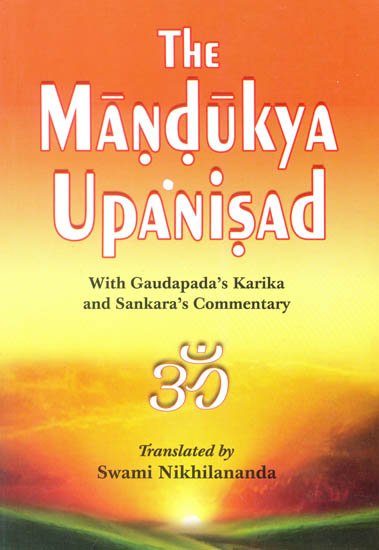Mandukya Upanishad (Gaudapa Karika and Shankara Bhashya)
by Swami Nikhilananda | 1949 | 115,575 words | ISBN-13: 9788175050228
This is verse 12 of the Mandukya Upanishad English translation, including commentaries by Gaudapada (Karika), Shankara (Bhashya) and a glossary by Anandagiri (Tika). Alternate transliteration: Māṇḍūkya-upaniṣad 12, Gauḍapāda Kārikā, Śaṅkara Bhāṣya, Ānandagiri Ṭīkā.
Mandukya Upanishad, verse 12
अमात्रश्चतुर्थोऽव्यवहार्यः प्रपञ्चोपशमः शिवोऽद्वैत एवमोङ्कार आत्मैव संविशत्यात्मनाऽऽत्मानं य एवं वेद ॥ १२ ॥
amātraścaturtho'vyavahāryaḥ prapañcopaśamaḥ śivo'dvaita evamoṅkāra ātmaiva saṃviśatyātmanā''tmānaṃ ya evaṃ veda || 12 ||
12. That which has no parts (soundless), incomprehensible (with the aid of the senses), the cessation of all phenomena, all bliss and non-dual Aum, is the fourth and verily the same as the Ātman. He who knows this merges his self in the Self.
Shankara Bhashya (commentary)
The amātroḥ (soundless1) is that which has no parts (sounds, etc., or letters). This partless Aum which is the fourth, is nothing but Pure Ātman. It is incomprehensible, because both speech and mind which correspond to the name2 and the object disappear or cease; the name and the object (that is indicated by the name) which are only forms of speech and mind cease or disappear (in the partless Aum), It is the cessation3 of the (illusion of) phenomena and all4 bliss and is identical with non-duality.5 Aum, as6 thus understood, has three sounds which are the same as the three quarters and therefore Aum is identical7 with Ātman. He who knows this merges8 his self in the Self which is the Highest Reality. Those who know Brahman, i.e., those who realise the Highest Reality merge into Self, because in their case the notion of the cause which corresponds to the third quarter (of Ātman) is destroyed (burnt). They9 are not born again, because Turīya is not a cause. For, the illusory snake which has merged in the rope on the discrimination of the snake from the rope, does not reappear as before, to those who know the distinction between them, by any effort10 of the mind (due to the previous impressions). To the men of dull or mediocre intellect who still consider themselves as students of philosophy, who having renounced the world, tread on the path of virtue and who know the common features between the sounds (mātrāḥ) and the quarters (or parts) as described above,—to them Aum, if meditated upon in a proper way, becomes a great11 help to the realisation of Brahman. The same is indicated in the Kārikā later on thus: “The three inferior stages of life, etc” (Māṇḍūkya Kārikā, Advaita Chapter, 16.)
Anandagiri Tika (glossary)
1 Soundless—It is because Amātra Aum cannot be expressed by any sound. It is relationless and therefore it cannot be described as the substratum of three other sounds. Sound points out, by contrast, the soundless Aum. All sounds must, at some time or other, merge in soundlessness. This Amātra Aum is identical with Turīya Ātman as described in a previous text (Upaniṣad 7).
2 Name, etc.—Name is but a form of speech or sound. All objects are again forms of mind. Both the name and the object are therefore mere ideas They disappear with the disappearance of the mind at the dawn of knowledge. Therefore soundless Aum like Turīya cannot be expressed by a name or pointed out as an object. Therefore it is incomprehensible.
3 Cessation—As the rope is realised when the illusion of snake disappears so partless (soundless) Aum is realised when the illusion of duality vanishes.
4 All bliss—This is a state of infinite and eternal bliss because no illusion which is the cause of misery exists there.
Fourth—Amātra is called fourth because it occupies the fourth place in order of explanation of Aum, of which three other states have previously been dealt with. Fourth does not signify any numerical relationship with the three aspects of Aum described previously.
5 Non-duality—From the standpoint of the relative world, the soundless state is the substratum of all illusory appearances. One can speak of duality only in the relative world.
6 As thus, etc.—i.c., with reference to the identity of the sounds and quarters as explained above.
7 Identical with—Three quarters, viz., Viśva, Taijasa and Prājña are imagined to subsist in Ātman. Viśva merges in Taijasa, Taijasa in Prājña and finally Prājña which is looked upon as the cause of the two preceding states merges in Turīya Ātman. Similarly the three sounds. A, U and M ultimately merge in the soundless Aum. In soundless Aum, the three sounds become identical with it as the three states are identical with Turīya from the absolute standpoint. Therefore Turīya Ātman is the same as soundless Aum.
8 Merges— That is, the knower realises himself as Turīya.
9 They are, etc.—It may be contended that like a man coming back to the realm of duality having experienced deep sleep, the knower of Self who has identified himself with Turīva may also come back to the illusory universe, for Prājña and Turīya are identical having a common feature of the perception of non-duality. This contention is without ground, because Turīya is not a cause. Hence it cannot give rise to the world of illusory experience. Unlike Prājña it is beyond all relations of cause and effect. Therefore one who has identified himself with Turīya can never see the illusion of the manifold.
10 Effort of mind— All efforts of mind are nothing but ideas. Our so-called illusory experiences and their opposite in the relative plane are nothing but ideas To a man who has
realised ideas as non-different from Brahman, no illusion which is of the nature of existence separate from Brahman, is possible.
11 Great help—Those students who cannot at once think of the soundless Aum or Turīya Ātman proceed step by step and ultimately realise the Highest Truth.
(Here ends the Māṇḍūkya Upaniṣad with the Commentary of Śaṅkara.)
